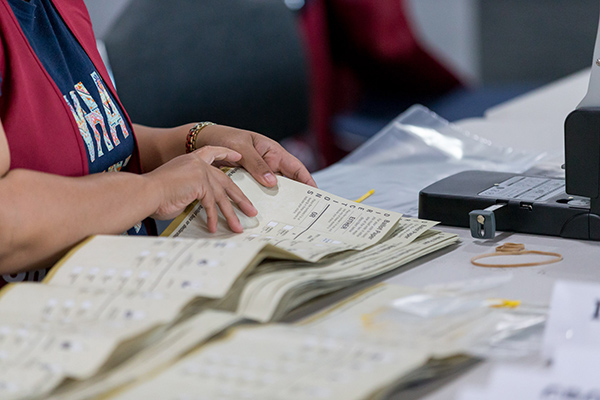Addendum: This article was written to be published in the leadup to the recent Victorian election. However, the Victorian Electoral Commission strictly prohibits election workers making statements about elections and I was refused approval to publish. Despite my frustration at having to hold the article, I am reassured by their vigilance about maintaining the neutrality of the administration of our election processes. Now that the election and my time as an election manager is concluded, my reflections can be published and I hope you find them insightful.
***
“Stop the count!” Trump tweeted in November 2020. His supporters then raged against the ballot counters, threatening to swarm the buildings. I couldn’t believe my eyes. Because I’ve worked at elections at all three levels of Australian government and such circumstances are inconceivable here. Martin Luther King III is similarly troubled and believes the US should consider adopting Australia’s compulsory voting system to protect democracy. The fallout from Trump’s election loss including claims of a stolen election should make us embrace our election processes and provoke the USA to alter theirs. Here’s why:
It is compulsory to vote (or at least cast a ballot) at elections in Australia; you will be fined if you do not. Of the 203 countries in the world, only 14 have compulsory voting where a penalty is imposed for failing to vote. Even a relatively small fine motivates people to cast a ballot.
Compared to lacklustre turnouts in countries where voting is optional, Australian elections can boast of 90%+ turnouts for their elections. Compare this with the US election in 2020 which had its highest voter turnout with 66.8% of citizens casting a ballot.
The momentum for compulsory voting dates back to 1922 when voluntary voting turnout declined to less than 60%, almost a 20% drop from the previous election in 1919. Parliament determined that election outcomes should reflect the will of the electorate. Voting became compulsory at the federal level in 1924 and the states followed soon after.
The implications of compulsory voting are many. It requires the electoral roll to be kept current, which is managed by the Australian Electoral Commission (AEC). Either the voter updates their details directly or other agencies such as Vic Roads, the Australian Taxation Commission or Australia Post inform the AEC and the electoral roll is updated. In fact, once on the electoral role, it’s really hard to get off it. Unless you move overseas, receive a prison sentence of 5 years or longer or are deemed incapacitated by a doctor, you are obliged to cast a ballot.
Voting must also be accessible. Until relatively recently, most people cast their ballot on election day. An acceptable reason had to be provided if you wanted to vote early or by post. Covid has changed all that. Nowadays, there is no impediment to voting early. Early voting centres open two weeks prior to election day and you can also apply for a postal vote. For the state election on 26 November 2022, the Victorian Electoral Commission (VEC) estimated over 50% of ballots would be cast prior to election day. and that indeed turned out to be the case.
Compulsory voting compels ease of voting. In November, voters were able to access one of over 1800 voting centres. including mobile teams visiting hospitals, aged care homes, homeless centres and prisons ensuring those voters could cast a ballot. Phone voting was available for the vision impaired; ballots in braille were available.
Ballot counters are trained to enfranchise voters where possible so if a voter’s intention can be ascertained, it will be included.
No identification is required to cast a ballot. Most people find this surprising, even alarming. This is to ensure that those who do not have any formal ID are not disenfranchised. Rest assured, voter fraud is almost non-existent.
I have watched and read with dismay the machinations in US elections, where obstacles to voting exist in many states, including an identification requirement where only certain identification is acceptable disenfranchising the homeless, poor and anyone without photo identification; where voting centre hours are cut resulting in queuing for many hours, where rural voters must drive for hours to access a voting centre.
Some moan about the compulsion to vote, that one should have the freedom to abstain from the process, to be politically disengaged, to not be forced to waste their time. The engaged voter may lament a disconnected voter’s equal entitlement to vote. May 2022 saw the peaceful transfer of power from the incumbent Coalition to the Labor Party. It also resulted in a wave of independent candidates upsetting the status quo in hitherto safe major party seats across Victoria and NSW. The momentum of dissatisfaction with the two major parties who received record low primary votes was able to be reflected and no cries of a stolen election were heard even by the most disappointed in the outcome.
Participating in the administration of democracy at our state election, while exhausting and pressured gave me enormous satisfaction. Despite hiccups with the unavailability of ballots when some early voting centres opened, despite some polling places running out of ballots, no one claimed interference with the process. And there was no one demanding the count be stopped.

